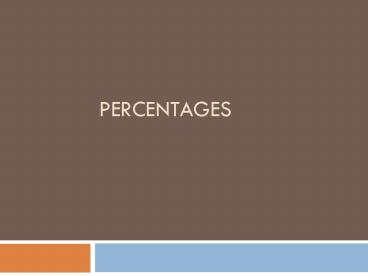Percentages - PowerPoint PPT Presentation
1 / 20
Title:
Percentages
Description:
In Chicago in 2000 there were approx 1.053 million African Americans, 907,000 ... The cost of tuition dropped by 14% over the last year at University Lah-Dee-Dah. ... – PowerPoint PPT presentation
Number of Views:43
Avg rating:3.0/5.0
Title: Percentages
1
Percentages
2
Percentages
- There are six basic types of percentage problems
- Creating a percentage
- Percentage of
- Percentage change
- Percent more than
- Successive percentage change
- Reverse percentage change
- And one simple ratio
- Times more than
3
1. Creating a Percentage
- In Chicago in 2000 there were approx 1.053
million African Americans, 907,000 whites,
754,000 Hispanics, and 181,000 others. What
percentage of Chicagoans were of Hispanic origin? - Remember part over whole
- 754,000 / (1,053,000907,000754,000181,000)
0.26 or 26
4
2. Percentage Of
- 54 of DePauls student body is female. DePaul
has approx 21,000 students. Approximate how many
females attend DePaul. - Multiply total by percentage
- 21,000 0.54 11340
5
2. Percentage Of
- 65 of US citizens have xyz insurance
- Of those that have xyz insurance, 20 of those
have the premium policy - What percentage of US citizens have the premium
policy?
6
3. Percentage Change
- You are examining one thing and how it has
changed over time - Chicagos population grew from 2.78 million in
1990 to 2.90 million in 2000. By how many
percent did it grow? - Divide difference by original value
- (2.90 2.78) / 2.78 0.043 4.3
7
3. Percentage Change
- In 1996, 94,007 tons of waste were recycled in
Chicagos blue bag program. In 2000, 296,363
tons were recycled. By how many percent did it
increase? - Divide difference by original value
- (296,363 94,007) / 94,007 2.15 215
8
4. Percentage More Than
- You are comparing two different examples of
something - The life expectancy in Canada is 79.1 years while
it is 76.0 years in the U.S. By how many percent
is the life expectancy in Canada higher than in
the U.S.? - Divide difference by latter value stated in
problem - (79.1-76.0) / 76.0 0.041 4.1
9
4. Percentage More Than
- The dropout rate of school X is 23.5 while the
dropout rate of school Y is 18.2. By how many
percent is the dropout rate of school X higher
than the dropout rate of school Y? - Divide difference by latter value
- (23.5 18.2) / 18.2 0.29 29
10
4. Percentage More Than
- Country X has 3.2 cars per family
- Country Y has 1.4 cars per family
- By how many percent is the average cars per
family for country X greater than country Y?
11
5. Successive Percentage Change
- The Formula (1 P1) (1 P2) 1 (where
the is written as a decimal) - P1 First percentage increase/decrease
- P2 Second percentage increase/decrease
12
5. Successive Percentage Change
- You are buying a sweater at the store. The tag
says it is 25 off. The sign above the rack says
take another 20 off the tag price. What is
total off of the sweater? - 100 - 25 75
- Take another 20 off of 75 (0.2 0.75 0.15),
so thats another 15 off. - Total -25 -15 -40
- Example What if sweater originally 100?
- Using the formula (1-.25)(1-.20)-1.40 or 40
13
5. Successive Percentage Change
- Spot prices for crude oil are rather volatile.
From 1998 to 1999, spot prices decreased by 28.
From 1999 to 2000, they increased by 16. What
was the percentage change over the two year
period from 1998 to 2000? - (1-.28)(1.16)-1.1648 or 16.48
14
5. Successive Percentage Change
- Spot prices for crude oil are rather volatile.
From 1998 to 1999, spot prices decreased by 28.
From 1999 to 2000, they increased by 106. What
was the percentage change over the two year
period from 1998 to 2000? - 100-28 72 (first year)
- 72106 76.3 (second year)
- -28 76.3 48.3 total increase
15
5. Successive Percentage Change
- The stocks you are holding dropped in value by
30 the first year. - In the second year, they increased by 12.
- In the third year they increased by 8.
- What was the total percentage change over the
three year period? - Use the formula
16
6. Reverse Percentage Change
- According to the official 2000 census, the
Hispanic population of the U.S. was 35,305,818.
It rose by 57.9 from 1990 to 2000. What was the
Hispanic population in 1990? old (1 change)
new - P (10.579) 35,305,818
- P (1.579) 35,305,818
- P 35,305,818 / 1.579
- P 22,359,606
Current Value (2000)
Percentage change ()
Original Value (1990)
17
6. Reverse Percentage Change
- You just spent 46.23 for a new pair of jeans.
This was the total price with sales tax. You
know that sales tax was 7.5. What was the price
of the jeans before the tax was added? - P ( 1 0.075) 46.23
- P 1.075 46.23
- P 46.23 / 1.075 43.00
18
6. Reverse Percentage Change
- The cost of tuition dropped by 14 over the last
year at University Lah-Dee-Dah. - This year tuition costs 23,000.
- What was the cost of tuition last year?
- P (1 0.14) 23,000
19
Times More Than
- The life expectancy in Canada is 79.1 years while
it is 76.0 years in the U.S. How many times more
is the life expectancy of Canada higher than the
life expectancy in the U.S.? - Divide former by latter
- 79.1 / 76.0 1.041
20
Times More Than
- The dropout rate of school X is 23.5 while the
dropout rate of school Y is 18.2. - How many times is the dropout rate of school X
higher than the dropout rate of school Y? - Divide former by latter
- 23.5 / 18.2 1.29































